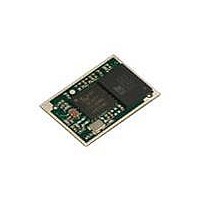DVK-BTM411 Laird Technologies, DVK-BTM411 Datasheet - Page 27

DVK-BTM411
Manufacturer Part Number
DVK-BTM411
Description
BLUETOOTH EVAL BOARD BTM411
Manufacturer
Laird Technologies
Type
Transceiverr
Specifications of DVK-BTM411
Frequency
2.4GHz
Wireless Frequency
2.402 GHz to 2.48 GHz
Interface Type
UART
Data Rate
2.1 Mbps
Operating Voltage
3 V to 3.3 V
Antenna
Multilayer Ceramic Integrated
Operating Temperature Range
- 30 C to + 70 C
Output Power
4 dBm
Technology/ Type
Development Kit
For Use With/related Products
BTM411
Lead Free Status / RoHS Status
Lead free / RoHS Compliant
Lead Free Status / RoHS Status
Lead free / RoHS Compliant, Lead free / RoHS Compliant
Other names
DVK-BTM411
Available stocks
Company
Part Number
Manufacturer
Quantity
Price
Company:
Part Number:
DVK-BTM411-02
Manufacturer:
LAIRD
Quantity:
2
BTM410/411
Bluetooth
AT COMMAND SET
REFERENCE
27 www.lairdtech.com
®
AT Data Module
AT Commands for a Selected Peer Device
This section describes AT commands to make the BTM Bluetooth device connectable for one particular remote
device only or to connect to a particular remote device on reset or on power cycle automatically.
8. SSO – S Registers
1. AT+BTP<bd_addr> {Make Device Discoverable and Selectively Connectable}
The following table lists S registers for SSO profiles.
Make the BTM device discoverable (for all devices) and connectable for the device with the Bluetooth
address <bd_addr> only. Connection requests from any other devices will be rejected.
If <bd_addr> is 000000000000 then incoming connections are accepted from any device, as per
AT+BTP without an address.
The setting remains valid until next reset or power cycle (unless not changed by any other AT
command subsequently). For permanent discoverable/connectable settings, please refer to S Register
512 and AT+BTM<bd_addr>
Response: <cr,lf>OK<cr,lf>
Register
S2
S12
S507
S531
S536
Default
94
100
0
0
0
Range
32..126
40..5000
0..2
0..4
0..1
Table 3.8: S Registers for SSO profiles
Description
Escape sequence character. It is not ‘+’ by default as a
Bluetooth serial link can be used to connect to a mobile
phone which exposes an AT command set, which will in turn
use ‘+’ as default. So if both used ‘+’ there will be confusion.
94 is the character ‘^’.
Escape sequence guard time in milliseconds, with a
granularity of 20ms. New values are rounded down to
the nearest 20ms multiple
When set to 0, a connection can be dropped using ^^^
escape sequence only and the state of DSR line is ignored.
When set to 1 a connection can be dropped using EITHER the
^^^ escape sequence OR the DSR handshaking line. When set
to 2, a connection can only be dropped using a deassertion of
DSR. Mode 2 provides for the highest data transfer rate.
If the status of the DSR line is to be conveyed to the remote
device as a low bandwidth signal then this register MUST be
set to 0, otherwise a deassertion of DSR will be seen as
a request to drop the Bluetooth connection.
This register affects S Register 536 – see details of 536
Specifies the mode on connection establishment.
0 = Normal, that data is exchanged between UART and RF
1 = LOCAL_COMMAND. UART input is parsed by the AT
interpreter and RF data is discarded
2 = REMOTE_COMMAND. RF input is parsed by the AT
interpreter and UART data is discarded. If S Reg 536 is not
1 then this register cannot be set to 2 and an ERROR will be
returned
3 = LOCAL_COMMAND. UART input is parsed by the AT
interpreter and incoming RF data is sent to the host using the
RX<string> asynchronous response.
4 = LOCAL_COMMAND and on the rf side, the gpio is
automatically sent when there is a change in input (digital I/O
cable replacement mode).
When set to 1, a remote device can ‘capture’ the AT parser of
this unit by it sending this module an escape “!!!” sequence.
The inter character timing is set via S Register 12.
If S Register 507 is >= 2, then reading this register will always
return 0 and writing 1 will result in ERROR 33.
Laird Technologies




















